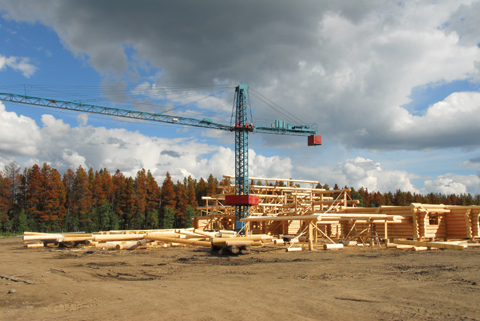The average log home can take anywhere from four to eight months or more to build, depending on its size. A custom log home is well worth the time and effort. Prior to construction, you plan for months, sometimes years, to make this vision become real. Because of the many stages that happen before the home is ready to move in, the construction process can seem daunting. Understanding the steps beforehand makes you a well-prepared consumer. It is your knowledge and passion to build a log home that help guide you through the process. “Log home construction takes conventional construction, opens up an entirely different world of customization, and adds in a strong dose of appreciation to our history,” says Phil Mattison, project manager of PrecisionCraft Log & Timber Homes and Mountain Architects in Meridian, Idaho. Here, we discuss the log home building process that takes your cumulative plans and transforms them into your future home.
Finding the right builder is the first step in the construction process. The builder is the person who oversees the entire construction of your home from beginning to end. “This can be the most important decision a log home buyer can make,” Phil says. “The right builder on-site can make a buyer’s vision and dreams come to reality.”
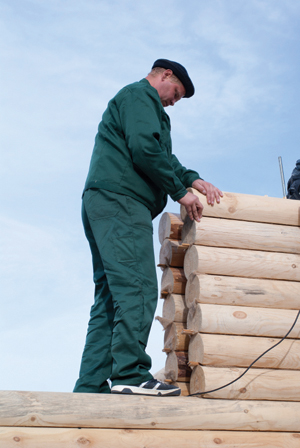
A good place to start your search is with recommendations from your log home producer. If you are working with a log home company dealer, this person may also be a builder-dealer who can construct your home. Or, your dealer can supply a list of recommended builders in your area. Check with your log producer, who may have a network of trusted builders that they can recommend. “It is important to find contractors who have performed work on that particular company’s log product,” advises Josh Watson, project coordinator of Honest Abe Log Homes in Moss, Tennessee. “Researching contractors through their previous customers tends to work well.”
There are also some log home companies, like PrecisionCraft Log & Timber Homes, that have programs to aid in this decision. “One of the project oversight options we offer to our clients is the Builder Bid Administration Program,” says Phil. “This program involves qualifying builders, requesting bids and estimated timelines for completion, and thoroughly reviewing and evaluating all builder bids received.”
If you have already researched and hired your own builder, find out what type of project management or technical assistance your log home company provides. Most companies offer a construction manual and recommend a tour of their facility or model home to familiarize your builder with their process. Other companies may have a team that comes to your site to stack the logs or a consultant who can assist with the stacking. Ask your log home producer if there is a contact person available to your builder who can be reached with questions during construction.
With your builder hired, the next step in construction is to clear the land. After the lot has been surveyed and any setback requirements noted, the area is cleared of trees and debris. This area includes the building site and a place for material storage. “This can be a relatively simple process if you are building in a flat field where little to no clearing is required,” says Josh. “Or it can be quite involved if it is a heavily wooded, steep lot that requires a lot of heavy equipment and manpower.” Next, the basement is excavated.
Once the land has been prepped, the foundation is built. First the footers are poured. This can be done in about a day, depending on the size of the home. Next comes the foundation. How this is accomplished depends on the type of foundation your home will have: poured concrete, concrete blocks or Insulated Concrete Forms, to name a few. If the walls are to be poured, forms are set. Any reinforcement steel is placed then the concrete is poured. Once dry, the forms are removed and the foundation is ready.
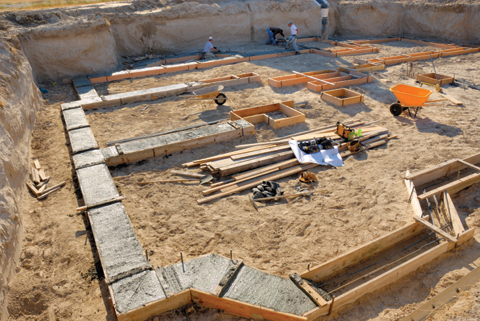
Now that the foundation is in place, it is time to build the subfloor. According to Josh, subfloors typically start with a sill plate fastened atop the foundation by anchor bolts or another mechanical fastener embedded into the concrete. The sill plate is treated to resist decay. A sealing gasket or metal termite shield is often placed between the foundation and the treated plate. Floor joists are typically constructed with dimensional lumber, such as 2×10 or 2×12, as required by code. Floor trusses are popular in instances where long, free spans are desired. Other products, such as engineered I-Joists, are also widely used alternatives for joists. The subfloor decking may be constructed using boards, plywood or an Oriented Strand Board (OSB) panel. Some OSBs are treated to better withstand the elements that the exposed sub-floor may be subjected to. The decking may be glued and secured with ring-shank nails or screws to guard against squeaks. The next step is sure to be one of the most exciting days during the building process: log delivery day. Clear communication with and between your builder and the log home producer is the key to ensuring a smooth delivery.
Substantial access to the site is imperative for the delivery truck to enter and exit. This means providing a wide enough road to access the property as well as clearing any tree branches and overhead wires that could get in the way. If it is a tight space or if it is a tough spot to access, your builder may want to have a small staging area in a more accessible place and transport the product up in smaller loads. And, Josh recommends staggering the deliveries depending on what’s needed first. “This helps with having enough room at the site,” he says.
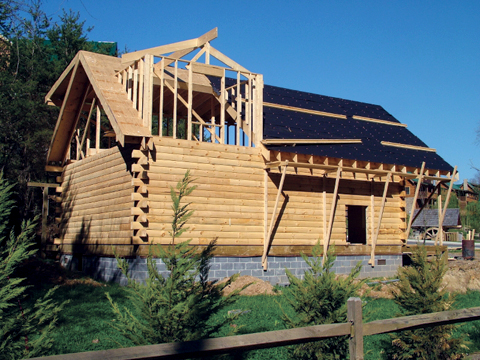
The crew then offloads the materials. The job of the truck driver is to deliver the logs, not to offload them. It is up to your builder to have the proper manpower and equipment, such as a crane or forklift, at the site to remove the logs from the truck. Not having the right equipment causes delays that will cost you money. Log materials require plenty of room to be stored. Create a staging area away from the foundation, but close enough to easily move the logs onto the subfloor when ready.
The logs are now ready to be stacked and your home truly comes to life. Course by course, logs are stacked either by hand or by crane for larger logs until the proper log wall height is reached. The logs are fastened together using the log home producer’s specifications. These methods include spikes, lag screws and through bolts. The logs are sealed at log intersections and between courses using special gaskets, caulk, or chinking. All electrical chases should be drilled before or during the log-stacking process. “Stacking the logs is usually one of the quickest phases with an experienced crew,” Josh adds.
Now it is time to make the home weathertight. “A log home is considered weathertight or dried-in when all of the exterior impermeable barriers are installed and sealed,” Phil says. This consists of exterior siding, soffits and impermeable underlayment. For the roof this includes roof decking, impermeable overlayment, and the finishing material, such as shingles or metal. Then, all of the exterior windows and doors are installed according to the manufacturers’ specifications. Caulking and exterior trim are finished.
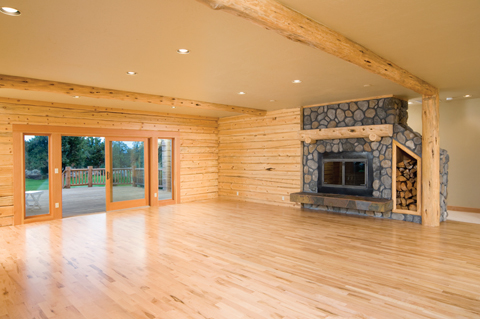
Once the log home is at the dry-in phase, finish construction can begin. A masonry contractor completes any fireplaces, hearths, or chimneys. HVAC, plumbing and electrical are installed. Interior walls are built, drywall installed and prepared for paint by a drywall contractor. Insulation is placed in walls and ceiling. The interior walls are painted or stained and/or wall coverings applied. Final flooring is placed including hardwood, ceramic tile, and carpeting. All interior finish and trim is done, including door installation, hardware, interior window and door trim, and baseboards. Then cabinetry, countertops, mirrors, medicine cabinets, and towel bars are installed. Tubs and showers are also completed, as are plumbing fixtures. Appliances are hooked up. Garage doors are installed, any decks are built and landscaping is completed with final grading, seeding or sod, and plant materials. The duration of the finishing process depends on both the size of your home and the level of materials specified.
A successful construction project involves clear communication with your general contractor and log home producer. Being aware of the process gives you a better understanding of how all of the time you have spent planning becomes home.

